|
The SA 330 was developed in the 1960’s
to meet a French Army requirement for an all weather day/night capable
helicopter. Built with a streamlined fuselage and retractable undercarriage
the Puma is fast and agile. This together with two large sliding doors
on each side of the cabin makes for a helicopter which is ideal for
rapid deployment of around sixteen troops. Before completion of the
project, Britain and France entered into a joint agreement over several
aircraft types and the Puma SA 330E was chosen to meet an RAF requirement
for a tactical medium transport helicopter.
This Anglo-French agreement was made
on 22 February 1967 but since these were to be manufactured by Westland,
and the necessary tooling was required prior to construction, the RAF
only received their Puma’s on 14 June 1971.

|
The first prototype flew on 15 April 1965
and by 1969 when the French started receiving their first Puma
SA 330B’s, the SAAF became one of the first foreign buyers of
the export version which was the SA 330C and had improved Turmo
IV engines. The SAAF purchased twenty. (Serials 121-140), 140
being a VIP model.
VIP model seats were actually “airline” seats taken from a DC-4.
Right: SAAF’s first Puma SA330C
( F-WMHB) seen at “Calvi” Corsica 20th Nov 1969.
Photo © GV Swanepoel
|
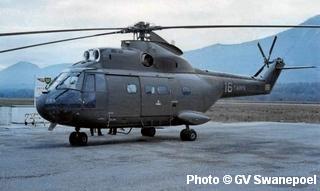 |
|
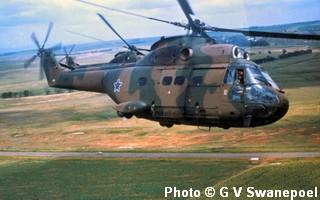
Puma “127” which was later sold to EADS Germany.
Photo © GV Swanepoel
|
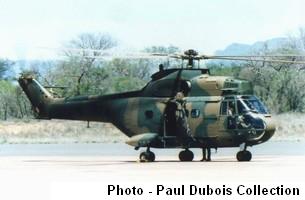
Puma “130”, note the thin stream-lined sponson together with
the “box” shaped sand filters.
Also visible is the hoist used for winching.
Photo © Paul Dubois collection
|

|
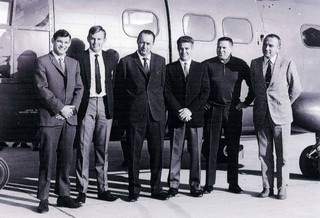
|
In October 1969 four pilots
(Kmdt S Armstrong, Maj J M Oosthuizen, Lt. G V Swanepoel and
Lt J W van Rooyen.) together with a technical team arrived at
Marignane for conversion training which lasted until December.
First SAAF Puma pilots
course in France 1969
Left to right; Lt. Joe van Rooyen, Lt. GV Swanepoel, Cmdt Steve
Armstrong, Major Jollie Ooosthuizen, Roland Coffignot (Aerospatiale)
and Jean Boulet (Aerospatiale)
(Photo courtesy GV Swanepoel)
|
|
Also during 1969 the Rhodesians
were quick to realize the true potential of the Puma and in
June 1969 sent a team to fly and assess the Puma. Unfortunately
due to the limited number of users, at that time, a method around
the Arms Embargo against Rhodesia could not be found and it
was only after the independence of Zimbabwe that their air force
obtained the bigger brother of the Puma, in the form of two
AS532 Cougars delivered in April 1995. SAAF Puma’s and RAF Puma’s
did operate in Rhodesia/Zimbabwe prior to this.
Participating in the Rhodesian Puma test flight were
Left to Right - Gp Capt. John Mussell, Gp Capt. Alec Thomson,
Wg Cdr Charlie Goodwin, Air Cdr Jimmy Pringle, Mr. Trollope
(Sec. Defence), AVM Archie Wilson, Monsieur Moullard, PJH Petter-Bower,
Wg Cdr Ken Edwards and Henry Ford (Rhotair).
|
3rd June 1969
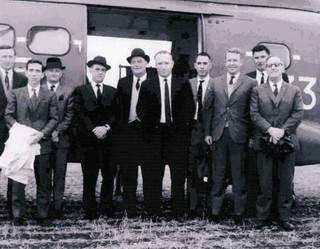 (Photo
courtesy PJH Petter-Bowyer) (Photo
courtesy PJH Petter-Bowyer) |

Puma “121” (ex F-WMHB) and Puma 122 (ex
F-WMHK) arrived at AFB Ysterplaat for assembly by 11 Air Depot in January
1970. No. 19 Squadron was formed at AFB Swartkop for the new helicopters
on the 1 March 1970, with Cmdt. Armstrong as OC. Puma “121” and “122”
were ferried to AFB Swartkop on the 31 January 1970 and formally taken
on charge on 1st May 1970.
In June 1972 “B” Flight
was formed at Durban as the Puma was ideal for Search and Rescue OP’s
as was to be proven time and time again.
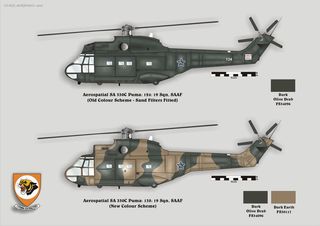 |
A modern diagram showing Puma
SA 330C in old and new colours. No 124 top and No 138
bottom.
Drawing Copyright © William
S Marshall 2006
Click for
larger image.
Original size image (3504 x 2478) available on request.
Please
e-mail webmaster.
|

In January 1975 a further eighteen Puma’s
were purchased. Serial numbers 141-160. Serial 150 was omitted due to
this already having been allocated to the VIP Viscount. These Puma’s
were the newer “H” models. The SA 330H was identified by the repositioned
Pitot tubes and squared off sponsons for accommodating emergency flotation
gear for over water operations and initially the box shaped sand filters,
although these were later replaced with the more common cylindrical
filters. They were fitted with the more powerful Turmo IVA engines.
All the “H” models were delivered and
assembled at Snake Valley near Pretoria. Later most of these would be
upgraded to SA 330 “L” standard with the assistance of the Romanian
company IAR. (Now Eurocopter Romania.)
| Finally in a rush
to beat the mandatory arms embargo of the 4th November 1977
a final order for 29 SA 330 “L” Puma’s was ordered (Serial’s
160-190) and delivered from the 1st November 1975. The last
Puma was delivered on 6th October 1978. The “L” model differed
from the “H” by having composite main rotor blades which improved
performance drastically. The MTOW for the “H” was 15400lbs compared
with 16300lbs for the “L”. Prior to upgrading the SA 330H, Atlas
Aircraft rebuilt SA 330C “135” to the “L” standard.
Right:
Puma '175' Nelspruit 2001. Photo © Robert Adams
|
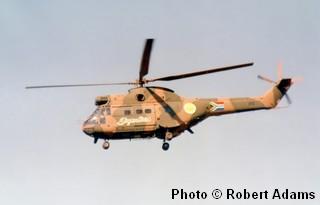
|

|
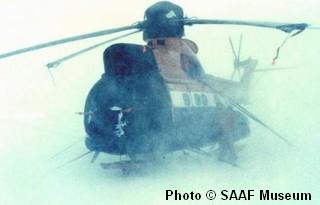
|
During 1980 the SAAF managed to obtain two
civilian Puma variants, namely the SA 330 “J” which was a civilian
version of the SA 330 “L”. These were operated by 30 Squadron
and were mainly used for the Antarctic missions aboard the SAS
Agulhas. They maintained civilian registrations ZS-HIZ and ZS-HJA.
Left:
One of four civilian SA 330J’s bought by the SAAF, two ZS-HIZ
and ZS-HJA were operated from the SAS Agulhas in Antarctica.
(Photo-SAAF Museum)
|

|
A further two SA 330 J’s were acquired, in
September 1984 (ZS-HNK and ZS-HNJ) becoming 189 and 190 in SAAF
service, later being used for the development of the first XTP-1
Beta attack helicopters. 189 being used primarily for weapons
trials, including the first launch of the V3B air-to-air missile
from a helicopter.
Right:
Puma "189" XTP-1 Beta
Photo © Phillip Evans
|
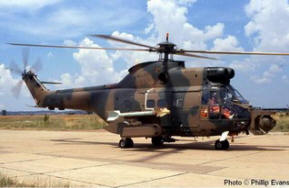 |

|
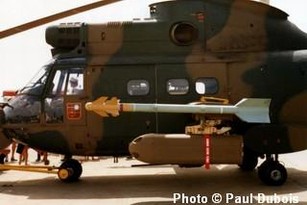
Puma “177” XTP-1 Beta attack
helicopter seen at AFB Pietersburg 1990.
This helicopter became the first “Oryx" "1250”
Photo© P. Dubois
Click for larger image
|
Up until 1980 various armaments
were fitted to the Puma from the 7.62 MAG, .50 Browning, 12.7mm
gun until the 20mm cannon firing from the starboard side. From
1980 it reverted back to flying unarmed until 1986 when the
Atlas XTP-1 Beta was developed. This version had the doors sealed
shut to accommodate two stub wings capable of carrying the under
nose Kentron TC-20 20mm cannon slaved to a helmet mounted site
and provision for four 68mm rocket pods or antitank missiles
and air-to-air missiles.
During this development
the need for a more powerful engine became apparent. In early
April 1986 Armscor set about a clandestine project to acquire
the Makila turboshaft engines which had already been successfully
flown on the SA 330R prior to the development of the Super Puma.
In a complex operation believed to involve Beverley Securities
Incorporated, Aerospatiale, Portuguese Air Force, Indep and
Ogma; Armscor agreed to pay for the upgrade of the Portuguese
Air Force Puma’s which entailed fitting Makila 1A turboshafts
to the standard Puma airframe.
|
This upgrade package was supplied in “kit” form by
Aerospatiale. This deal was worth about $3 billion and Aerospatiale
continued delivering these “kits” to Portugal where, apart from those
used by the Portuguese upgrade the rest were delivered to South Africa
via a front company in Zaire over a five year period. Puma “177” subsequently
became a Puma on “steroids” with a far better performance and a potentially
new helicopter for the SAAF.
Together with IAR who supplied
50 Puma airframes without tailbooms in 1986, South Africa developed
a new version of the Puma known locally as the Oryx. South Africa chose
the IAR airframe over existing airframes due to the Romanians use of
carbon-composite materials which are lighter, stronger and also include
sponson fuel tanks which give an extended range.
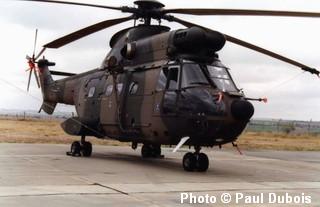
Oryx 1224 seen at Lanseria, which is from
19 SQN
Photo © Paul Dubois |
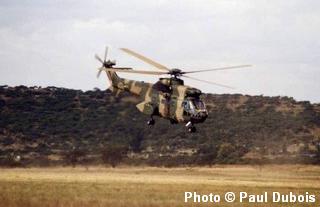
Oryx 1248 seen lifting from a shooting range in the OFS. This
Oryx is with 87 HFS. Note the larger sponson’s. Photo © P Dubois
|
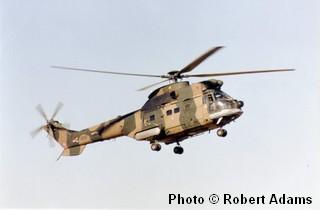
Oryx 1232 Photo © R Adams |
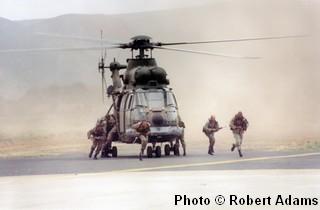
Oryx 1236 Photo © R Adams |
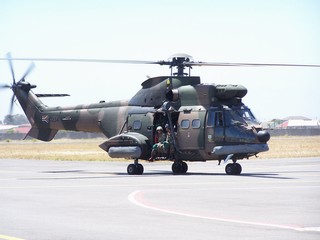
Oryx 1234 Photo © LM |
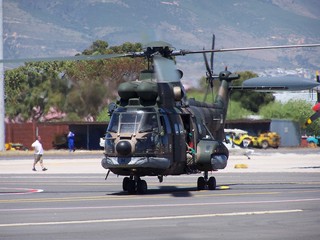
Oryx 1234 Photo © LM |
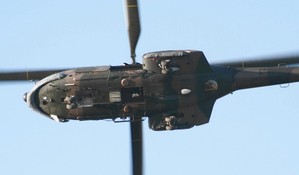
Oryx 1244 Photo © D C |
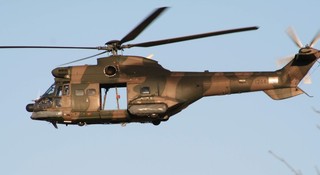
Oryx 1244 Photo © D C |

The SAAF Puma’s were used by 15 Squadron
(Durban), 16 Squadron( Port Elizabeth), 17 Squadron(Pretoria), 19 Squadron(Pretoria/Durban),
22 Squadron (Ysterplaat), 30 Squadron( Ysterplaat) and 31 Squadron (Hoedspruit).
|
The Puma has been used in conjunction
with the Army, Navy and Police. It has been used in desert,
snow, maritime and mountain conditions in war and peace. It
has been used for trooping, search & rescue and flood relief.
Some of the more famous rescue operations entailed rescuing
in 1973, 27 crew members from the “Neptune Sapphire” which sank
160km off Port St. Johns, and 21 crew members off the “Pep Ice”
which was stranded on a coral reef in the Indian Ocean during
1980.
A Puma was dismantled and loaded on board
a Transall aircraft and then flown from Pretoria to Europa Island
where it was assembled gain. From there the Puma flew
some 65 km’s to the Danish Freighter. The crew of the Puma was
Maj P J Stannard and Maj R Dean. The rescue operation lasted
about 3 hours.
|
19 Squadron - AFB Swartkops
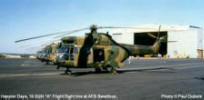
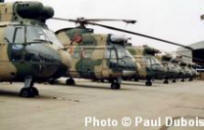
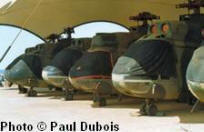
|
Probably the most famous was the sinking
of the Oceanos in August 1991, near the Eastern Cape.
Amongst other aircraft, thirteen Puma’s from 15, 19 and 30 Squadrons
took part, of those nine were used to hoist up the
survivors. The Puma’s rescued a total of 225 survivors. Other
tasks included finding people lost in the mountains or rescuing
people during Cyclone Demoina or various floods. During February
1988, four Puma’s were used to overturn a coup attempt in Bophuthatswana
and in June 1990 two Puma’s onboard the SAS Tafelberg were used
in the rescue of a family being held hostage in Mozambique by
rebels.
Puma’s also went to Mauritius in 1987
to assist with the recovery of wreckage from an SAA B747 which
had crashed into the ocean and have been used to rescue
members of the SANAE team
taken ill in the Antarctica.
|

On the 31 January 1972 the SAAF Puma
became involved with operations in SWA (Namibia) and Angola, remaining
involved until 1988. This first deployment to the Eastern Caprivi led
to the first member of the SAAF to be awarded the Honoris Crux, one
of several to be awarded to Puma crews.
The Puma was to be involved in normal
trooping, rapid deployment during “follow up” operations, radio relay,
evacuation of casualties, rescuing downed aircrew, insertion of Special
Forces (Ops Backlash and Kodak etc.) and large scale cross border operations
such as Savannah, Uric, Protea, Super, Moduler etc. The Puma also saw
action in Rhodesia, Zambia, Botswana and Mozambique.
Puma’s either made the eight hour ferry
flight from Pretoria to Ondangwa in SWA/Namibia or were flown by C-160
Transall aircraft.

During the Bush War four Puma’s were
lost to enemy fire and one to friendly fire.
| 22/12/1975
- |
Puma
134 - |
shot down NW
of Cela, Angola by Cuban AAA. |
| 04/01/1976
- |
Puma
122 - |
shot down in
Angola by friendly fire. |
| 04/09/1979
- |
Puma
164 - |
shot down in
Mozambique by RPG-7. |
| 05/01/1982
- |
Puma
168 - |
shot down in
Angola by AK-47 fire which ruptured the hydraulic pipe. |
| 09/08/1982
- |
Puma
132 - |
shot down at
Cassinga, Angola by 23mm AAA. |
A further four Puma’s were written off
during accidents in the operational area.

|
The Puma fleet accumulated
53 000 hours before being phased out in 1998. The most hours
being flown by Charlie Tait who obtained around 3500 hours on
the Puma.
During March 1994 the Romanian government placed an order for
17 ex-SAAF Puma’s but only twelve were sold and at least ten
of these were refurbished by IAR (Now Eurocopter-Romania) for
onward sale to the UAE.
Right: Atlas/Denel
offered all the ex-SAAF Puma’s for sale and one idea marketed
was this civilian VIP version. Photo © Paul Dubois
|
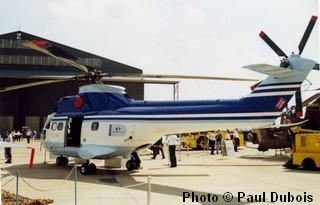 |

Grant Williams of News Air Lease Ltd
UK bought 144, 148, 167, 169, 172, 173, 184 and sold 144, 148, 172,
169, 173 and 184 to the RAF. These were shipped by sea and arrived at
Felixstowe in 2002.
The RAF serials are;
| SAAF No |
Airframe No |
Reg No |
| 144 |
1310 |
ZJ954 |
| 148 |
1363 |
ZJ955 |
| 172 |
1374 |
ZJ956 |
| 169 |
1474 |
ZJ957 |
| 173 |
1420 |
ZJ958 |
| 184 |
1378 |
ZJ959 |
173/184 will remain in storage at Llangennech, Wales with the
MOD storage facility. Since RAF fleet numbers are reducing these
will probably not be recovered.
|
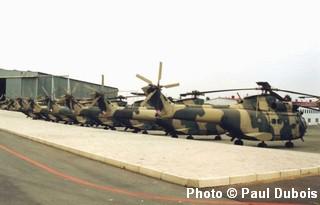
|
173/184 will remain
in storage at Llangennech, Wales with the MOD storage facility.
Since RAF fleet numbers are reducing these will probably
not be recovered.
Left:
Puma’s stored at AFB Swartkop, 173 was sold to the RAF and
became ZJ958 and 153/157 were sold to the civilian operator
Starlite.
Photo © Paul Dubois
|
The airframes had low hours and were predominantly
sound apart from some corrosion. In order to retain standard certification
and to retain the HC.Mk1 annotation (this simplifies support capabilities
and configuration control, thus reducing costs), a number of SAAF
modifications and equipment such as floatation gear had to be removed.
To this end the four Puma’s were shipped to Eurocopter
Romania (IAR) were the SAAF Puma’s were changed from the H/L models
back to the basic C/E model. This entailed the removal of the two
Turbomeca Turmo IVC turbo shaft engines and the fitting of two lesser
powered Turmo IIIC-4 turbo shaft engines.
New sponsons/undercarriage fairings had to be
fitted to replace the squared-off ones that had been used for the
floatation gear. The pitot tubes were lowered from the central position
they had before. The two piece centre plexiglass was replaced with
a single piece to accommodate anti-icing and an extra windscreen
wiper was attached to this. The steel mesh protector over the upper
plexiglass was replaced with a more solid steel plate.
After five hours flying at Brasov Puma 144 was
shipped back to the UK in July 2004 for final modifications at Agusta
Westland’s Yeovil facility. Apart from the power plant, over about
thirty years of RAF service the RAF Puma’s had had most of the L-
models mods done! So Westland had to completely rewire and system
fit to the HC.Mk1 standard. Also two wire strike ramps were fitted
to the cockpit canopy, either side of the centre panel. Since a
number of components are obsolete, these had to be reverse engineered.

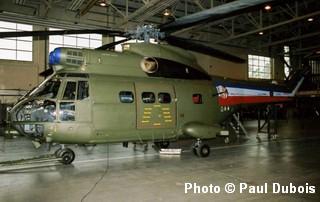
Puma ZJ954 aka 144 seen at RAF Benson, May 2006. Note colours
for celebrating the 90th Anniversary of 33 SQN RAF.
Photo © Paul Dubois |
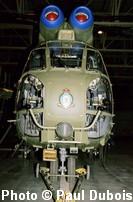
A frontal view of ZJ954 clearly showing the changes made
to 144.
Photo © Paul Dubois |
Puma 144 aka ZJ954 was handed to the RAF on 3
May 2006 and ZJ955 is due in August 2006.

A large number of ex-SAAF Puma’s have also been
sold to civilian operators such as Starlite.

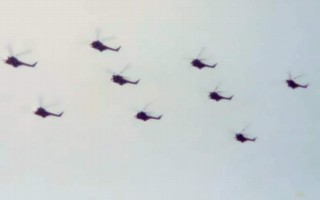
Formation of Pumas over Pretoria
Photo © Paul Dubois |
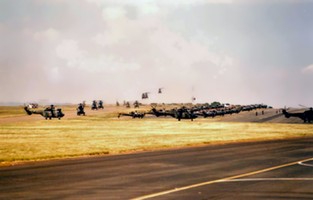
A very busy apron of Alouette III’s and Oryx’s seen at AFB
Swartkop, home of 19 Sqn.
Photo © Paul Dubois
|
Copyright © Paul Dubois 2006
|
